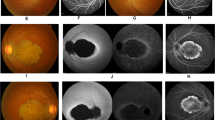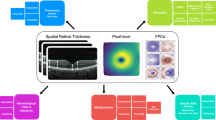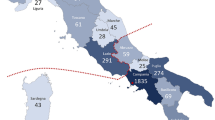Abstract
Aims:
To describe the phenotype of members of a large Caucasian British family affected by autosomal dominant cone–rod dystrophy due to an R838C mutation in the guanylate cyclase 2D (GUCY2D) gene encoding retinal guanylate cyclase-1 (RETGC-1).
Methods:
Retrospective review of 29 patients from four generations of the same family.
Results:
Visual symptoms usually commenced in childhood. Only two patients, aged 14 and 25 years, had visual acuity compatible with driving. Of the 12 patients aged over 40 years, eight (66%) had vision of counting fingers or worse and were eligible for blind registration in the UK. Of the 29 patients, 18 (62%) had myopia greater than 5 D in at least one eye. Most had discernible macular changes on biomicroscopy, which varied from subtle RPE change to gross macular atrophy. All patients who underwent computerised perimetry exhibited a central or paracentral scotoma with normal peripheral field of vision. Of the 21 patients who underwent electrodiagnostic testing, all exhibited decreased cone function, but rod function was normal in 12 (57%) patients.
Conclusion:
We believe this report highlights the importance of phenotype–genotype correlation in cone and cone–rod dystrophies. Increased understanding of the varying phenotypes associated with different genetic mutations allows appropriate counselling of patients. In addition, the phenotypic characterisation of the natural history of these conditions may prove valuable in the future should therapeutic interventions become available.
Similar content being viewed by others
Log in or create a free account to read this content
Gain free access to this article, as well as selected content from this journal and more on nature.com
or
References
Simunovic MP, Moore AT . The cone dystrophies. Eye 1998; 12: 553–565.
Kelsell RE, Evans K, Gregory CY, Moore AT, Bird AC, Hunt DM . Localisation of a gene for dominant cone–rod dystrophy (CORD6) to chromosome 17p. Hum Mol Genet 1997; 6(4): 597–600.
Kelsell RE, Gregory-Evans K, Payne AM, Perrault I, Kaplan J, Yang RB et al. Mutations in the retinal guanylate cyclase (RETGC-1) gene in dominant cone–rod dystrophy. Hum Mol Genet 1998; 7(7): 1179–1184.
Payne AM, Morris AG, Downes SM, Johnson S, Bird AC, Moore AT et al. Clustering and frequency of mutations in the retinal guanylate cyclase (GUCY2D) gene in patients with dominant cone–rod dystrophies. J Med Genet 2001; 38(9): 611–614.
Perrault I, Rozet JM, Gerber S, Kelsell RE, Souied E, Cabot A et al. A RETGC-1 mutation in autosomal dominant cone-rod dystrophy. Am J Hum Genet 1998; 63(2): 651–654.
Weigell-Weber M, Fokstuen S, Torok B, Niemeyer G, Schinzel A, Hergersberg M . Codons 837 and 838 in the retinal guanylate cyclase gene on chromosome 17p: hot spots for mutations in autosomal dominant cone–rod dystrophy. Arch Ophthalmol 2000; 118(2): 300.
Van Ghelue M, Ericksen HL, Ponjavic V, Fagerhein T, Andreasson S, Forsman-Semb K et al. Autosomal dominant cone–rod dystrophy due to a missense mutation (R838C) in the guanylate cyclase 2D gene (GUCY2D) with preserved rod function in one branch of the family. Ophthal Genet 2000; 21(4): 197–209.
Tucker CL, Woodcock SC, Kelsell RE, Ramamurthy V, Hunt DM, Hurley JB . Biochemical analysis of a dimerization domain mutation in RETGC-1 associated with dominant cone–rod dystrophy. Proc Natl Acad Sci USA 1999; 96(16): 9039–9044.
Wilkie SE, Newbold RJ, Deery E, Walker CE, Stinton I, Ramamurthy V et al. Functional characterization of missense mutations at codon 838 in retinal guanylate cyclase correlates with disease severity in patients with autosomal dominant cone–rod dystrophy. Hum Mol Genet 2000; 9(20): 3065–3073.
Hanein S, Perrault I, Gerber S, Tanguy G, Barbet F, Ducroq D et al. Leber congenital amaurosis: comprehensive survey of the genetic heterogeneity, refinement of the clinical definition, and genotype–phenotype correlations as a strategy for molecular diagnosis. Hum Mutat 2004; 23(4): 306–317.
Downes SM, Payne AM, Kelsell RE, Fitzke FW, Holder GE, Hunt DM et al. Autosomal dominant cone–rod dystrophy with mutations in the guanylate cyclase 2D gene encoding retinal guanylate cyclase-1. Arch Ophthalmol 2001; 119(11): 1667–1673.
Acknowledgements
We thank Torbay Medical Research Fund for sponsoring the molecular analysis.
Author information
Authors and Affiliations
Corresponding author
Additional information
Proprietary interests: Nil
Rights and permissions
About this article
Cite this article
Smith, M., Whittock, N., Searle, A. et al. Phenotype of autosomal dominant cone–rod dystrophy due to the R838C mutation of the GUCY2D gene encoding retinal guanylate cyclase-1. Eye 21, 1220–1225 (2007). https://doi.org/10.1038/sj.eye.6702612
Received:
Accepted:
Published:
Issue date:
DOI: https://doi.org/10.1038/sj.eye.6702612
Keywords
This article is cited by
-
Phenotypic characterization of autosomal dominant progressive cone dystrophies associated with a heterozygous variant c.2512C>T of GUCY2D gene in a large kindred
Eye (2022)
-
Longitudinal OCT and OCTA monitoring reveals accelerated regression of hyaloid vessels in retinal degeneration 10 (rd10) mice
Scientific Reports (2019)
-
GUCY2D mutations in a Chinese cohort with autosomal dominant cone or cone–rod dystrophies
Documenta Ophthalmologica (2015)
-
A detailed phenotypic description of autosomal dominant cone dystrophy due to a de novo mutation in the GUCY2D gene
Eye (2014)
-
Clinical course of cone dystrophy caused by mutations in the RPGR gene
Graefe's Archive for Clinical and Experimental Ophthalmology (2011)



